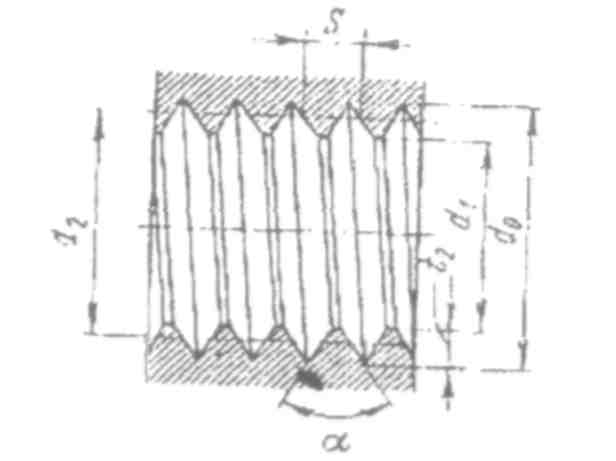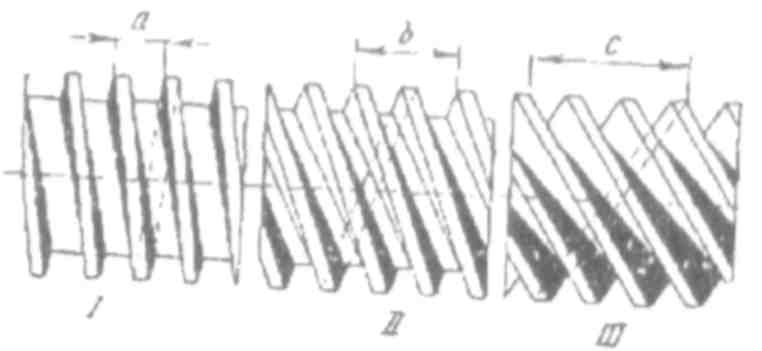
- •2. Steel
- •4. Properties of engineering materials and methods of testing them
- •1. Chipping metal and chipping tools
- •2. Metal-cutting and locksmith's cutting tools
- •3. Filing and filing tools
- •4. Mechanical tools
- •5. Measuring tools and devices
- •1, 2, 3, 8 -Jaws; 4 - adjusting screw; 5 - primary scale; 6 - depth rod;
- •6. Machine-cutting tools
- •7. Drills and drilling
- •8. Threading tools
- •9. Methods of holding tools between centres
- •10. Holding work in a chuck
- •II. Holding work in a vice
- •Chapter III machine parts
- •1. Welding
- •2. Induction brazing and soldering
- •3. Threads
- •4. Gears
- •5. Belt and chain drives
- •6. Bearings
- •7. Clutches
- •Chapter IV metal-cutting machines
- •1. Lathes
- •2. Drilling machines
- •3. Milling machines
- •4. Planers
- •5. Shapers and slotters
- •6. Grinding and grinding machines
- •Chapter V texts for home reading
- •1. The russian metallurgist d. K. Chernov
- •2. Oxygen in the bessemer converter
- •3. Oxygen enrichment in the blast furnace
- •4. Oxygen for direct reduction of iron ore
- •5. Crucible furnace
- •6. Portable hardness tester
- •7. High-speed precision ball bearing testing machines
- •Составные предлоги
- •Сокращения
- •Англо-русский словарь
3. Threads
Threads are applied for interconnection of machine parts and for transmitting motion from one part to another. When a thread is cut on the outside of a part it is known as an "external" or "male thread". A thread is called an "internal "or "female thread" when cut inside a part. Depending on the shape of the threading tool different profiles of thread are obtained, such as triangular, square or trapezoidal, shown in Fig. 33.
triangular thread, or V-thread |
|
square thread, or flat thread |
|
buttress thread |
|
trapezoidal thread or acme thread |
|
round thread |
|
Fig. 33. Profiles of Threads
In practice triangular threads are most widely used. The main elements of a thread are: the angle of the thread, the major, minor and pitch diameters, the depth and the pitch. These elements are shown in Fig. 34.

Fig. 34. Main Elements of a Thread:
d1 - minor diameter; d0 - major diameter; d2 - pitch diameter; S - pitch; t2 - depth
The angle of a thread is the angle included between the sides of the thread and measured in an axial plane. The major, or outside, diameter of a thread d0, (sometimes referred to as "full diameter") is the distance between the two extreme outside points of the thread in the direction square to the axis1.
The major diameter is the largest diameter of the thread of a screw or a nut.
The minor diameter db being the smallest diameter of the thread, is the distance between the two extreme inside points of the thread measured at the right angle to the axis. The minor diameter is also called the "core diameter" or "root diameter".
The pitch diameter d2 is the distance between the two opposite parallel sides of the thread profile perpendicular to the thread axis. The depth t2 of the thread is the distance between the crest and the base of the thread measured normal to the axis, or
t2=(d0-d1)/2.
A crest is the top surface joining the two sides of a thread, while a base of a thread is the bottom surface joining the two adjacent threads. The pitch of a thread is the distance from a point of thread to the corresponding point of the next thread measured parallel to the axis.
Screw threads are of both right-hand and left-hand types. In right-hand threads the direction of the thread is from the right to the left. Right-hand threaded screws are turned clockwise to be screwed into a nut, while left-handed screws should be turned counterclockwise to do that.

Fig. 35. Screw Thread:
I - single thread screw; II - double thread screw; III - triple thread screw; a, b, с – pitch
In screw fastenings threads are made of various shapes, but always of the triangular type, such as: single thread, double thread and triple thread (Fig. 35). On the type of the latter depends the lead of the thread which is the distance a screw thread advances axially in one turn. On a single thread screw the lead and the pitch are the same; on the double thread screw the lead is twice the pitch, while on a triple thread screw the lead is three times the pitch.
The most widely used systems of triangular threads in machine-building are: metric, inch and pipe threads. Each thread has its own angle and application. A metric thread profile resembles a triangle with an angle of 60° at its apex. Such a thread is widely used for bolts and nuts. An inch tread profile has an angle of 55°. This type of thread may be used when making spare parts for foreign-made machines. An angle of 55° is also used with pipe threads. Pipe threads are applied for gas and water pipes, as well as for clutches connecting such pipes.
1. in the direction square to the axis - в направлении, перпендикулярном к оси
Exercises
I. Use the following wards and phrases in sentences of your own:
round thread, internal thread, triple thread, profiles of thread, triangular thread, square thread, buttress thread, pitch of thread, right-hand thread, screw thread, single thread, left-hand thread
II. Retell the text giving answers to the following questions:
1. What are threads used for? 2. What types of threads do you know? 3.What are the main elements of a thread? 4. What types of screw threads do you know? 5. What are the most widely used systems of triangular threads in machine-building?
III. Find in the text synonyms of the following words and word combinations:
square thread, trapezoidal thread, major diameter, minor diameter, root diameter
IV. Analyse and translate the following sentences:
1. The metal cannot be compressed, but is cold forged into a different form, and what takes place when the thread shaped dies are forced into the metal to form a thread is displacement of the surface which is forced into grooves, that is, the material from the depressions forms the elevations on either side. 2. The V-shaped thread must not be made sharp because the sharp crest of the V-thread is very easily broken, and the taps and dies will not stand long due to the sharp thread. 3. The finished thread is of greater diameter than the original diameter of the wire, which in turn is larger than the diameter of the finished thread at the root. 4. A screw or bolt of a given size has a greater minor diameter and a greater strength if the pitch is fine rather than coarse. 5. The finished product is therefore larger in diameter than the blank by an amount approximately equal to the depth of the thread. 6. This process of rolling threads, grooves and screw blanks is used in the manufacture of many articles in preference to cutting the threads or grooves with ordinary slow-cutting tools or threading dies.
V. Make up as many questions as possible concerning the following sentences:
1. During the operation the metal is cold forged into a different form. 2. The finished thread is of greater diameter than the original diameter of the wire. 3. A crest of a thread is the top surface joining the two sides of the thread. 4. A base of a thread is the bottom surface joining the two adjacent threads. 5. In screw fastenings threads are made of triangular type.
VI. (a) Read and translate the following text using a dictionary:
The process of rolling screw threads has been greatly developed and its usefulness extended by the rather recent introduction into common use of a material suitable for roll threading. Iron of ordinary quality does not lend itself well to this process on account of its fibrous structure, which makes this material liable to split or fracture under pressure, but in the modern low-carbon steel we find a material in
every way suited to the rapid and economical forming of screw threads. By this process the blank is rolled between two flat dies with their working surfaces grooved to the shape of the thread required, these grooves being cut across the face of the dies at the proper angle to suit the pitch and diameter of the screw.
(b) Retell the text.
VII. On the basis of Fig. 38 describe what profiles of thread are obtained depending on the shape of the threading tool.
VIII. Giving answers to the following questions describe the main elements of a thread as shown in Fig. 34:
l. What are the main elements of a thread? 2. What is the angle included between the sides of the thread called? 3. What is the distance between the two extreme outside points of the thread in the direction square to the axis called? 4. What is the largest diameter of a thread called? 5. What is the minor diameter of a thread? 6. What is called the "pitch diameter" of a thread? 7. What is the distance from a point of thread to the corresponding point on the next thread measured to, the axis called? 8. What is the depth of a thread?
IX. Describe the shapes of threads in screw fastenings on the basis of Fig, 35.
